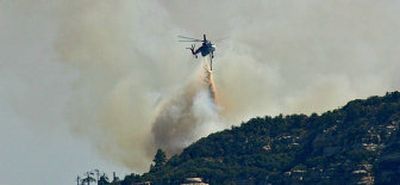Climate ideal for fires across much of West

SEDONA, Ariz. – A lingering drought has created ideal wildfire conditions across much of the West and Southwest this summer, alarming forestry officials, who already are dealing with an unusually high number of fires.
Nationwide as of Saturday, officials have reported 54,686 fires charring more than 3.2 million acres, according to the National Interagency Fire Center in Boise, Idaho. Both figures were the highest in at least a decade for this point in the year. The 10-year average for the same date was 39,240 fires burning about 1 million acres.
So far, none of the fires has spun out of control, but scientists and forestry officials warned that exceptionally light rains and low humidity in many states have left dry, dead branches and grasses that could ignite like a tinderbox.
“Basically, you have had low precipitation since the late 1990s, and now, a winter in which we got close to no precipitation” in the Southwest, said Chuck Maxwell, a meteorologist with the Department of the Interior who months ago predicted a severe fire season. “The fuel moisture levels are very low. The humidity is very low. There are lots of places now that are as dry as we have ever seen them.”
One such place is the scenic red-rock country around the resort town of Sedona, about 90 miles north of Phoenix. Firefighters spent most of last week battling a blaze that threatened to spill down the candy-colored walls of Oak Creek Canyon, a bucolic area just north of town. About 30 businesses and 430 residences – from modest trailers to resorts and million-dollar estates – were evacuated last Sunday.
The fire, which had burned more than 4,000 acres, was 20 percent contained as of Saturday. The area sweltered in 100-degree heat all week, which made it tougher to stop the fire. Flames crept down the west wall of the canyon – bristling with dried-out willows, cottonwood and pine. Firefighters ignited backfires along the road that winds through the canyon bottom to keep the fire from jumping across Oak Creek and spreading toward Sedona.
Wildfire season typically peaks in late summer and early fall, and some fire experts cautioned against drawing dire conclusions from a rash of fires during the first half of the year. A series of fast-moving grass fires that roared through Oklahoma and north Texas this spring accounted for nearly a third of the acres charred so far, they noted.
“We are just as dry, if not drier, than we were in 2002, when we had huge wildfires in the west, so that should certainly serve as a warning,” said Dan Binkley, director of the Colorado Forest Restoration Institute at Colorado State University. “But a lot depends on what happens during the rest of the season. If you get some rain in the right places, it could merely be a bad fire year, instead of a historic one.”
In response to the fire risk, Colorado Gov. Bill Owens banned fireworks on state-owned land, while Arizona Gov. Janet Napolitano declared a state of emergency and ramped up 211 telephone lines to spread information on fire conditions.
It was the fire threatening the outskirts of Sedona that firefighters declared the top national priority because of its proximity to people, resorts and pricey real estate. Napolitano underlined the urgency of corralling the fire earlier in the week, calling Sedona the “jewel of Arizona.”
The fire forced the closure of Coconino National Forest between Sedona and Flagstaff, a popular summer camping destination. More than 4 million people pass through the forest every year, many on the way to the Grand Canyon.